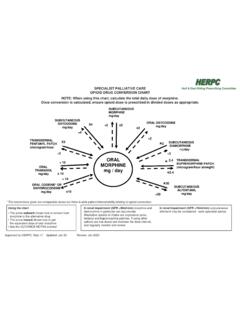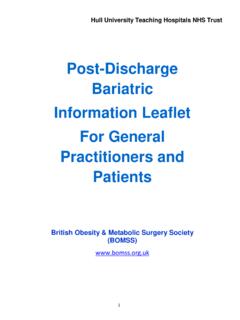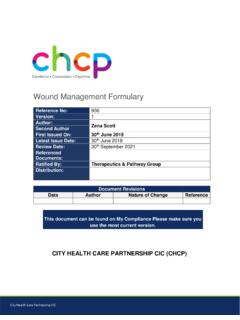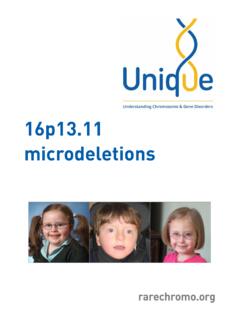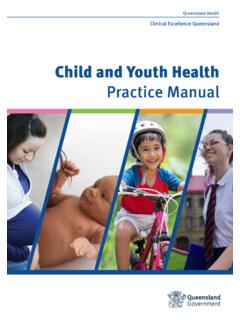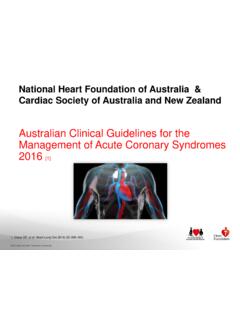Transcription of Appropriate Prescribing of Specialist Infant Formulae
1 Prescribing Guideline: Appropriate Prescribing of Specialist Infant Formulae Approved: HERPC Jan 2015 Updated: July 2018 Review: July 2021 Page 1 of 16 Hull & East Riding Prescribing Committee Bulletin 67 | July 2014 | Appropriate Prescribing of Specialist Infant Formulae Over the counter products to be used initially Introduction Whilst these guidelines advise on Appropriate Prescribing of Specialist Infant Formulae , breast milk remains the optimal milk for infants. This should be promoted and encouraged where it is clinically safe to do so and the mother is in agreement.
2 Purpose of the Guidelines These guidelines aim to assist GPs and Health Visitors with information on the use of prescribable Infant formula. The guidelines are targeted at infants 0-12 months. However, some of the prescribable items mentioned here can be used past this age and advice on this is included in the guidelines. The guidelines advise on: Over-the-counter (OTC) products available where Appropriate Initiating Prescribing Quantities to prescribe Which products to prescribe for different clinical conditions Triggers for reviewing and discontinuing prescriptions When onward referral for dietetic advice and/or secondary/ Specialist care should be considered.
3 Colour key used on the following pages: Over the counter products to be purchased Prescribe as first line Prescribe as second line Should not routinely be commenced in primary care Should not routinely be prescribed Please refer mothers that require additional support with Infant feeding, usually breastfeeding related issues to: Infant Feeding Co-ordinator City Health Care Partnership CIC Orchard Park Health Centre, 210 Orchard Park Road, Hull. HU69BX Tel: 07964 686958 Infant Feeding Lead Humber Teaching NHS Foundation Trust Trust Headquarters Willerby Hill, Beverley Road Willerby HU10 6ED Tel - 01482344510 Prescribing Guideline: Appropriate Prescribing of Specialist Infant Formulae Approved: HERPC Jan 2015 Updated: July 2018 Review: July 2021 Page 2 of 16 Guide on quantities of Formulae to prescribe For powdered formula.
4 Age of Child Number of tins for 28 days Under 6 months 13 x 400g tins or 6 x 900g tins 6-12 months 7-13 x 400g tins or 3-6 x 900g tins Over 12 months 7 x 400g tins or 3 x 900g tins These amounts are based on: Infants under 6 months being exclusively formula fed and drinking 150ml/kg/day of a normal concentration formula. Infants 6-12 months requiring less formula as solid food intake increases. Children over 12 months drinking the 600mls of milk or milk substitute per day recommended by the Department of Health.
5 For liquid high energy formula: Prescribe an equivalent volume of formula (500mls to 1000mls) to the child s usual intake until an assessment has been performed and recommendations made by a paediatrician or paediatric dietitian. Some children may require more, those with faltering growth. Review recent correspondence from the paediatrician or paediatric dietitian. 14 DOS AND DON TS OF Prescribing Specialist Infant Formulae DO Promote and encourage breast-feeding where it is clinically safe and the mother is in agreement.
6 Check any formula prescribed is Appropriate for the age of the Infant . Check the amount of formula prescribed is Appropriate for the age of the Infant (see page 1) and/or refer to the most recent correspondence from the paediatric dietitian. Review any prescription where the child is over 2 years old, the formula has been prescribed for more than 1 year, greater amounts of formula are being prescribed than would be expected or stop when able to tolerate OTC products Review the prescription if the patient is prescribed a formula for CMPA but able to eat any of the following foods cow s milk, cheese, yogurt, ice cream, custard, chocolate, cakes, cream, butter, margarine, ghee.
7 Prescribe only four weeks initially until compliance/tolerance is established. Remind parents to follow the advice given by the formula manufacturer regarding safe storage of the feed once mixed or opened. Refer where Appropriate to secondary or Specialist care - see advice for each condition. Refer where Appropriate to the paediatric dietitians. Seek Prescribing advice if needed in primary care from the Medicines Management Team. Seek Prescribing advice if needed in secondary care from the local Hospital Medicines Information Centre.
8 Prescribing Guideline: Appropriate Prescribing of Specialist Infant Formulae Approved: HERPC Jan 2015 Updated: July 2018 Review: July 2021 Page 3 of 16 DO NOT Add Infant Formulae to the repeat Prescribing template in primary care, unless a review process is established to ensure the correct product and quantity is prescribed for the age of the Infant . Prescribe lactose free Formulae (SMA LF , Enfamil O-Lac ) for infants with CMPA. Routinely prescribe soya formula (SMA Wysoy ) for those with CMPA or secondary lactose intolerance.
9 It should not be prescribed at all in those under 6 months due to high phytoestrogen content and should only be advised in patients who do not tolerate first or second line formula. Suggest milk and Formulae made from goat s milk, sheep s milk or mammalian milks for those with CMPA or secondary lactose intolerance. Suggest rice milk for those under 5 years due to high arsenic content. Prescribe Nutriprem 2 Liquid or SMA Gold Prem 2 Liquid unless there is a clinical need. Prescribe thickening Formulae (SMA Pro Anti-Reflux , Enfamil AR ) with separate thickeners or in conjunction with medication such as antacids, ranitidine, or proton pump inhibitors, since the Formulae need stomach acids to thicken and reduce reflux.
10 Suggest Infant Gaviscon more than 6 times in 24 hours or where the Infant has diarrhoea or a fever, due to its sodium content. Prescribe low lactose/lactose free Formulae in children with secondary lactose intolerance over 1 year who previously tolerated cow s milk, since they can use lactose free products ( ) from supermarkets. Prescribing Guideline: Appropriate Prescribing of Specialist Infant Formulae Approved: HERPC Jan 2015 Updated: July 2018 Review: July 2021 Page 4 of 16 COW S MILK PROTEIN ALLERGY (CMPA) Symptoms and diagnosis Refer to NICE guideline CG116 Food Allergy in Children and Young People Feb 2014 for full details.
